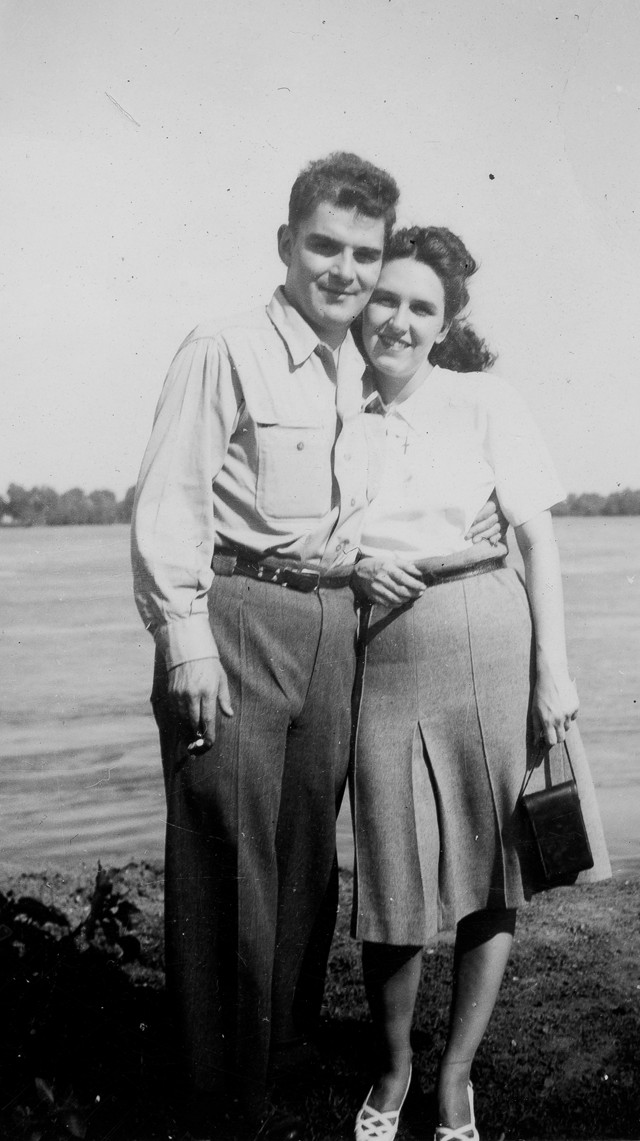
by Patrick C. Brayer Tuesday, July 26, 2016

Roger and Edith Brayer in the mid-20th century. Credit: courtesy of Patrick C. Brayer.
The account of how the crustacean Editia elegantis was discovered has been the source of dinner party amusement for my family and friends since I was a child. The lore surrounding this find is not a tale of a paleontologist traveling the planet to exotic locations, but rather a story of disagreement between a young wife and her graduate student husband set in a small kitchen in a tiny St. Louis apartment in the late 1940s or early 1950s. People are often surprised to hear that a simple disagreement between my father and mother resulted in an article in the Journal of Paleontology and a collection in the Smithsonian National Museum of Natural History. Such lofty results all depended on someone with no scientific training uttering the words: “That’s not sand!”
The story begins when my father, Roger, was a graduate student in the geology department at St. Louis University searching for specimens to complete his dissertation in the late 1940s to early 1950s. Roger and Edith — my mother — had been married for several years. My father would sit at the kitchen table and clean sand and other residue from rocks and stones, searching for fossil remains. One day, exhausted and unsuccessful in his quest, my father handed my mother a box of debris from his cleaning and told her with an air of authority that she could throw away the contents; “it was just sand.”
My mother is not one to easily accept authoritative proclamations. Without hesitation she looked at the contents of the box and made her own proclamation: “That’s not sand!” Anyone who knows Roger and Edith can easily visualize what followed: a spirited debate between two intellectually curious people both entrenched in their convictions.
After a back and forth, my father drew from his comparatively superior formal education and challenged my mother to prove her hypothesis; but the solution to this dilemma had a cost, one of her few and expensive nylon stockings would need to be sacrificed. Nylon was still a rare commodity after World War II and not an easily afforded extravagance. To Edith, this was a big sacrifice. Roger accepted both the stocking and the challenge to his scientific authority with confidence, explaining how the fine sand would sift through the nylon. It was also clear to both that the nylon would not survive untarnished.
Roger placed the discarded material inside the stocking and started to sift. As Edith cringed at the destruction of this needed accessory, Roger continued with more sifting and more sifting and still more. The expression on my father’s face represented confusion, disbelief and surprise until he finally uttered the magical words my mother wanted to hear: “That is not sand!” The residue that remained on the stocking was anything but sand. She had been right and her husband knew it.
Their lives changed after that moment. She saw her new husband far less than before as he immersed himself in the rigors of identifying, classifying and publishing on what she saved from the trash — fossilized records of some of the 24 species of small marine crustaceans classified as Ostracoda, never before identified, from the Salem limestone of St. Louis County, Mo. One group of 15 new species represented the discovery of two new genera, Brillius and Editia Brayer, not known to exist elsewhere. My father named several species after our family: My oldest brother Michael, who was about 2 when my father’s study was published, is forever known in the scientific community as Glyptopleura michaelis Brayer; my middle brother Mark, who’d just been born at the time, is Glyptopleurina embryonicia Brayer. (My younger sister Anne-Marie and I weren’t included as this occurred a decade before we were born.)
And of course, my father named one of the newly discovered species Editia elegantis in honor of my mother. When I view the magnified photograph of this specimen, I understand why my father picked this species to name after his wife. For me, a nonscientist, it appears different from the other samples in the collection — unique. To know my mother is to appreciate what her uniqueness and independent spirit meant to my late father. In 1952, my father published the Salem Ostracoda of Missouri in the Journal of Paleontology, thus solidifying my mother’s place in geological history.
In celebrating my mother’s contribution to science and to the intellectual endeavors of her family and friends, in this, her 90th year, we acknowledge the individuals who inspire us to reach further in discovering our world.
© 2008-2021. All rights reserved. Any copying, redistribution or retransmission of any of the contents of this service without the expressed written permission of the American Geosciences Institute is expressly prohibited. Click here for all copyright requests.